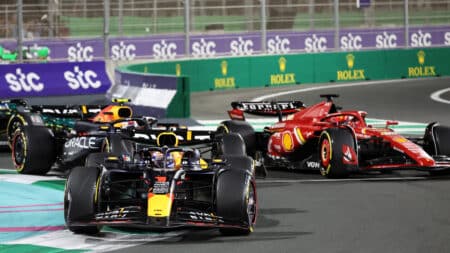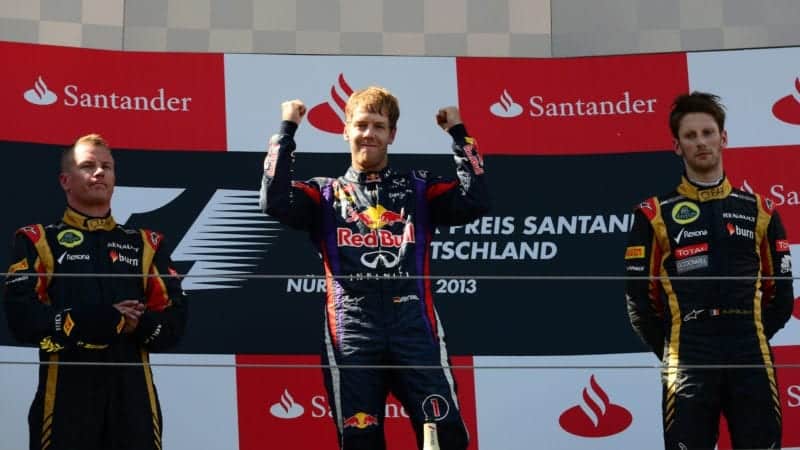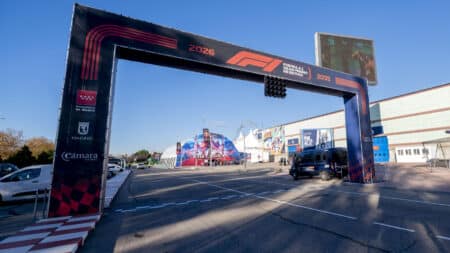
Which Red Bull will show up in Jeddah? - What to watch for at Saudi GP
Can Red Bull rebound from its poor Bahrain showing? And will it be Piastri or Norris leading McLaren's charge? Here's the five themes to watch for at the Saudi Arabian GP

Grand Prix Photo
Home, sweet home. It has taken a few attempts, but Sebastian Vettel finally has a German Grand Prix victory to add to his relentlessly expanding CV. He achieved it the hard way, too. Tyre tactics and strategy came into it, naturally, but this was racing as it is supposed to be – concentrated ferocity spiked with moments of unforeseen drama. The stuff on the track was uniformly good, too.
During the morning, ‘God Save the Queen’ had been more audible than German staples such as Scorpions or the Michael Schenker Group, with Melville McKee, Alexander Sims, Nick Yelloly and Lewis Williamson taking an all-British one-two-three-four in the GP3 Series and Jon Lancaster fending off James Calado in GP2. The prospects of Lewis Hamilton completing the set were dashed within the GP’s opening moments, however, as the pole-sitter got away sluggishly and was immediately mugged by both Red Bulls. Mark Webber briefly took the lead on the run to Turn One, but Vettel held the inside line and reclaimed the advantage at the corner’s exit.
Short first stints were expected for those on the softer Pirelli, but the medium-shod Felipe Massa was first to drop from the leading pack. This had little to do with tactics, however. Running sixth, the Brazilian locked his rear wheels at Turn One on lap four and spun to the outside. He then found his car jammed in fifth and, try as he might, was unable to bully it back onto the track. The engine eventually stalled and that was that.
Vettel came in for mediums on lap six and Webber followed one lap later, handing the lead to Romain Grosjean – whose light-footed Lotus was getting better tyre life than most in the prevailing heat. Webber’s stop was disastrous, however, the right rear wheel failing to locate and bouncing down the pit apron as he attempted to rejoin. It eventually struck Formula One Management cameraman Paul Allen, who suffered rib and collarbone fractures, plus concussion. Having been treated at the circuit medical centre, he was transferred to hospital for observation.
“He is fundamentally OK,” said Red Bull team principal Christian Horner, “and that was our primary concern. It’s a timely reminder, though, that the pits are a pretty dangerous place to be. It was a horrible feeling, but FOM kept me updated on his condition throughout the race. We chose not to inform Mark at that stage, because it was better not to be racing with that on his mind.”
Webber was pulled back to his pit and sent back out, one lap down, with the wheel securely refitted. Red Bull was later fined €30,000 for unsafe release, while Force India escaped with a €5,000 penalty for sending Paul di Resta out across Jean-Eric Vergne’s bows a couple of laps beforehand.
Alonso was expected to stay out for a while, but Ferrari called him in on lap 13 – one before Grosjean – because it felt the Spaniard’s performance was slightly south of expectations. At that stage Vettel led from Grosjean, Jenson Button (yet to stop), Nico Hülkenberg (ditto), Hamilton and Kimi Räikkönen, but the race’s complexion soon changed following the safety car’s intervention.
On lap 22, Marussia driver Jules Bianchi suffered a spectacularly fiery engine failure and pulled to the side of the circuit, just before the chicane. A recovery tractor had just arrived when the car began rolling backwards, across the track, although mercifully it didn’t hit anything substantial en route to the opposite verge.
The race was neutralised for five laps while the matter was sorted and the top four – Vettel, Grosjean, Räikkönen and Alonso – dived straight in for tyres. They were able to resume in front of Button and Hamilton, both of whom had stopped shortly beforehand.
“Without the interruption we’d probably have continued for another five to seven laps,” Horner said. “At that point it was potentially too far to go on a single set of harder tyres, so we opted to put Seb on scrubbed mediums and left one new set available for a final stint.”
Given the Lotus’s greater tyre range, the safety car didn’t do Grosjean any favours. For now, though, he was slightly quicker than Vettel courtesy of fresh mediums, although the German was driving flawlessly.
“We wondered whether the Lotuses might try to brave it out to the end,” Horner said, but that was answered when Grosjean made his final stop on lap 40. Next time around, Vettel followed. “Once Grosjean stopped,” Horner said, “it made perfect sense to cover him. The risk was conceding the lead to Kimi if he didn’t need to stop – and he looked in pretty good shape at that point.”
Grosjean’s extra lap on new tyres could have been a useful trampoline, too, but Vettel was told to push like hell during his in lap – and ended up increasing his advantage by a fraction. “The pit crew deserved great credit,” said Horner, “because their confidence had taken a bit of a knock after earlier events.”
Räikkönen and Alonso were now first and second, but both came in on lap 49. The Spaniard had no choice but to make one more stop, because he’d been on mediums from the start, but caution was the watchword for Lotus. “Kimi’s pace was beginning to drop,” said team principal Eric Boullier, “and our calculations suggested the tyres wouldn’t last. And remembering what happened during the final stages of Shanghai 2012 [when the Finn plummeted down the order on spent rubber], we wanted to be safe…”
He came out in third, running a scrubbed set of softs, and soon latched onto Grosjean’s tail. Split strategies dictated an inevitable change of positions, but Räikkönen had no more joy than his team-mate when it came to rattling the leader. He’d lost a few seconds behind Hamilton’s Mercedes after the first stops – and had to cope with a one-way radio for much of the race (he could hear the team, but the reverse wasn’t necessarily true). “That wasn’t ideal,” he said, “because there was a lot to discuss today, but ultimately we didn’t quite have the speed.”
Vettel duly crossed the line one second to the good, with Grosjean completing the top three from Alonso, the relatively gripless Hamilton and Button, who profited from a solid two-stopper. He felt he might have beaten his former team-mate, too, had he not lost time behind the squabbling Caterhams during the closing stages.
Having been able to reclaim his lost lap during the safety car period, Webber scythed through the pack to take seventh ahead of Sergio Pérez, Nico Rosberg and the worthy Hülkenberg, who made a late switch to softs and beat the two-stopping di Resta to the final point.
It had been a spectacular contest – and pure, too, with lap times dropping by about 3.5 seconds from start to finish, a reflection of no more than lightening fuel loads.
“Earlier this season we felt things had gone too far with tyre wear,” Horner said, “but drivers were really pushing today. It proved that you don’t need high degradation to produce good races…”

Can Red Bull rebound from its poor Bahrain showing? And will it be Piastri or Norris leading McLaren's charge? Here's the five themes to watch for at the Saudi Arabian GP

McLaren's breakthrough in a near-four-year-old ruleset shows F1 rules convergence is a myth – just like Sebastian Vettel, Red Bull and Renault did in 2013, writes Mark Hughes

Madrid finally has a consortium to build the new Formula 1 circuit that will host the 2026 Spanish GP

Helmut Marko caused a stir after the Bahrain GP with his worries that Max Verstappen could leave Red Bull early. But how real are those fears?